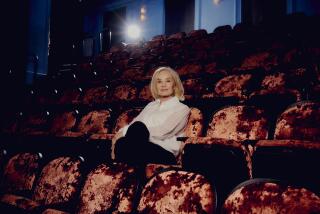Closer to the Near East
- Share via
“I was reading this book about archeology. . . .” So begins creator-director Stephen Legawiec’s casual introduction to “Ninshaba” at Glaxa Studios.
A more literate and personalized opening than “Once upon a time,” perhaps, but it ushers us into a theatrical world every bit as fanciful and imaginative as any fairy tale. With an innovative mix of narrative, mime, dance and costuming, Gilgamesh Theatre company makes an obscure Near East myth into something inviting and familiar.
From his perch amid piles of texts, papers and percussive instruments, Legawiec explains that his play originated in clay tablets from the ancient Turkish city of Ugarit, unearthed in Syria in the 1920s. The tablets contain the only complete version of a legendary young woman’s journey from her plague-ridden homeland to seek her unknown mother. Before each episode, Legawiec summarizes the contents of the appropriate tablet.
It’s a story that had been related for 4,000 years before it was ever written down, and comes to us with individual details burnished into archetypal elements through countless re-tellings.
To evoke that timeless sense, the company invented a pleasing, nonsensical language, with which the performers skillfully combine expressive movement to make their meaning clear. Occasional narration from Legawiec and a three-member chorus fill in any gaps.
The quest of Ninshaba (limber, eloquent Candace Reid) follows a familiar mythic pattern. In the midst of fever comes a vision that propels the maiden to seek her lost mother in a distant land. Accompanied by Quaqsaya, a mischievous, mercurial spirit (amusingly rendered by Dana Wieluns in the best commedia tradition), Ninshaba faces numerous perils and temptations in her wandering.
Naturally, the encounters symbolize critical life passages. An elegant, handsome suitor (Angela Backman) nearly seduces Ninshaba to marry despite Quaqsaya’s hilarious efforts to cool her friend’s ardor. A grieving mother, preying on Ninshaba’s good heart, coaxes her into joining her daughter’s funeral procession--until Ninshaba realizes the face of the dead girl is her own.
In his narration, Legawiec makes much of the puzzling seventh tablet, describing a seemingly unrelated harvest dance by a fertility goddess (Reid). Coming on the heels of the death episode, the theme of regeneration in this short interlude resonates even if it doesn’t advance the plot. (And, of course, it establishes the prehistoric origins of the seventh-inning stretch.)
The colorful characters are evoked with the help of Beckie Kraveta’s exotic masks. Among the most striking is a regal, mouse-headed guardian who tests Ninshaba’s integrity with a series of probing questions.
As in all such myths, Ninshaba’s journey is ultimately one of self-discovery. Yet the relative rarity of her being a woman-hero engenders some variation--there’s less emphasis on combat, and instead of having to do battle with the parent figure, the point of her quest is a mother and daughter reunion sweet enough for a Hallmark card.
BE THERE
“Ninshaba,” Glaxa Studios, 3797 Sunset Blvd., Silver Lake. Thurs.-Sun., 8 p.m. Ends March 23. $12. (213) 466-1767. Running time: 1 hour, 20 minutes.
More to Read
Sign up for our Book Club newsletter
Get the latest news, events and more from the Los Angeles Times Book Club, and help us get L.A. reading and talking.
You may occasionally receive promotional content from the Los Angeles Times.






